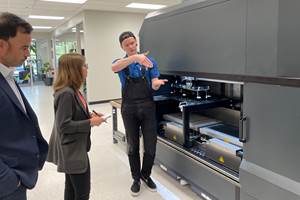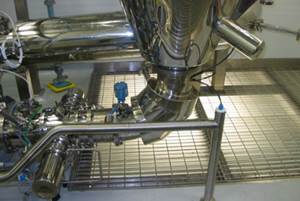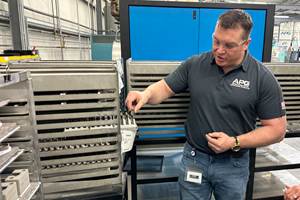3D-Printed Prototype Molds Versus Aluminum Tooling
An in-progress case study by Phoenix Proto Technologies aims to answer questions about what is—and isn’t—possible with 3D-printed molds.
According to Bob Lammon, president and founder of Phoenix Proto Technologies (PPT), 3D-printed molds get a bad rap. And he has seen this before. Aluminum molds, an established option for creating prototype injection mold tooling, still have their detractors, too. PPT provides customers with both options for prototyping molded parts: aluminum tooling and 3D-printed molds. So, as he does with questions about aluminum molds, Lammon also fields customers’ concerns about the limitations of 3D printing for creating injection molds and production-quality sample parts: they’re not fast enough, the quality is sub-par, the molds can’t tolerate heat or pressure, it’s difficult or impossible to over-mold, or to obtain a specific surface finish, or to use production-level materials.
As Lammon and PPT have had success in pushing back against these stereotypes with aluminum tooling (PPT has produced aluminum molds that have delivered 1 million shots), so too are they pushing back against misconceptions about 3D-printed molds and cavities—at least to a degree. To showcase the capabilities of additively-produced plastic molds as they stand today, Lammon and his associates offered me a behind-the-scenes look at an in-progress case study.
PPT’s study compares the mold-building processes between a conventional aluminum prototype mold cavity set and a 3D-printed set for final part design. In the image above, the part on the left was produced from a 3D-printed cavity (printed on a Stratasys Objet 260), while the part on the right was produced from an aluminum mold. Both parts were created with a PC/ABS resin, and both the 3D-printed cavity and the aluminum tool produced parts that were over-molded with a brass insert.
Pared down, the mold-building process for PPT’s case study consists of six steps. Here’s how those steps compare and contrast between each method:
|
Aluminum prototype mold |
3D-printed cavity set |
|---|---|
|
1. Design the mold |
1. Design the mold |
| 2. Program and cut in CNC machine | 2. Upload design to printer |
| 3. Create the mold components | 3. Create the mold components |
| 4. Build the frame | 4. (Not necessary) |
| 5. Final fitting | 5. Final fitting |
| 6. Polish | 6. (Not necessary) |
Of course, these steps have been simplified for explanatory purposes. They also make a few assumptions that should be noted. In particular, step four for the 3D-printed cavity set assumes that an initial investment has been made to build a universal frame to support 3D printed cavities in the injection molding machine. Once that is complete, Lammon notes, all future 3D-printed cavities could be designed to fit the existing frame.
Setting those caveats aside, steps two, four and six represent considerable time savings via the additive process. Notably, step two represents a significant reduction in the amount of processing time and manpower necessary to create the part. Programming cutter paths and CNC machining the aluminum block can take several hours, while uploading a CAD file to the 3D printer is nearly instantaneous. The printing cycle certainly takes time, but the need for skilled operator attention is practically nil.
Overall lead time for this final product created with a conventional aluminum prototype mold is typically one week, Lammon says, whereas production of a set of 3D-printed cavities was only two days. However, Lammon notes that while there was a significant amount of time saved during the tooling process, the opposite can be said during the molding process.
The overall cycle time in PPT’s case study was 175 seconds when using the 3D-printed cavities. With the aluminum mold, that time was only 44 seconds. This can be explained largely through the discrepancies between allowable heat and pressure. While the mold temperature was 70 degrees in the 3D-printed cavities, it was 125 degrees for the aluminum mold. The barrel temperatures reached 450 degrees with the 3D printed cavities, versus 520 degrees for the aluminum mold. And finally, the 3D-printed cavities required a 60-psi decrease on injection pressure, which represents a 10 percent reduction on velocity and a 50 percent increase of fill time to that of the aluminum mold.
While PPT’s case study found overall savings in both cost (25 percent) and turnaround time (50 percent) when using the 3D-printed cavities, there are still limitations that need to be overcome. The plastic cavities used in PPT’s study were printed with a proprietary digital ABS material from Stratasys, and finding the right mixture of materials that will increase the life of a 3D-printed mold will take time. Depending on the chosen resin, today each cavity set can produce between 50 and a few hundred shots—a small fraction of what’s achievable with aluminum (not to mention steel). Success rates can be increased by experimenting with gate location and size, but Lammon notes that design details nearest the gate will be more susceptible to wear and/or damage. PPT is experimenting with other steps that can be taken to extend the life of the 3D-printed cavities, such as increasing gate and runner sizes well over what would be necessary in an aluminum mold.
Related Content
Additive Manufacturing's Evolving Role at Fathom Now Emphasizing Bridge Production
Bridge production is currently the biggest opportunity for additive manufacturing, says Fathom Manufacturing co-founder Rich Stump. How this service provider leverages AM while finding balance with other production capabilities.
Read MorePowderCleanse Concept Delivers In Situ Powder Analysis for Metal 3D Printing
A collaborative project developed a prototype solution for measuring particle size distribution on the production floor, as part of the sieving step typical to additive manufacturing processes using metal powders.
Read MoreFaster Iteration, Flexible Production: How This Inflation System OEM Wins With 3D Printing
Haltec Corp., a manufacturer of tire valves and inflation systems, finds utility in 3D printing for rapid prototyping and production of components for its modular and customizable products.
Read MoreSinter-Based Additive Manufacturing Finds a Place Alongside MIM, Press and Sinter at APG
Powder metallurgy company Alpha Precision Group (APG) is applying a particular class of metal 3D printing technology for both rapid iteration in development and flexibility in production.
Read MoreRead Next
3D Printed Polymer EOAT Increases Safety of Cobots
Contract manufacturer Anubis 3D applies polymer 3D printing processes to manufacture cobot tooling that is lightweight, smooth and safer for human interaction.
Read MoreBike Manufacturer Uses Additive Manufacturing to Create Lighter, More Complex, Customized Parts
Titanium bike frame manufacturer Hanglun Technology mixes precision casting with 3D printing to create bikes that offer increased speed and reduced turbulence during long-distance rides, offering a smoother, faster and more efficient cycling experience.
Read MoreAlquist 3D Looks Toward a Carbon-Sequestering Future with 3D Printed Infrastructure
The Colorado startup aims to reduce the carbon footprint of new buildings, homes and city infrastructure with robotic 3D printing and a specialized geopolymer material.
Read More

















